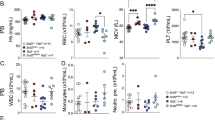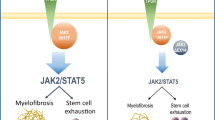Abstract
Alternatively spliced colony stimulating factor 3 receptor (CSF3R) isoforms Class III and Class IV are observed in myelodysplastic syndromes (MDS), but their roles in disease remain unclear. We report that the MDS-associated splicing factor SRSF2 affects the expression of Class III and Class IV isoforms and perturbs granulopoiesis. Add-back of the Class IV isoform in Csf3r-null mouse progenitor cells increased granulocyte progenitors with impaired neutrophil differentiation, while add-back of the Class III produced dysmorphic neutrophils in fewer numbers. These CSF3R isoforms were elevated in patients with myeloid neoplasms harboring SRSF2 mutations. Using in vitro splicing assays, we confirmed increased Class III and Class IV transcripts when SRSF2 P95 mutations were co-expressed with the CSF3R minigene in K562 cells. Since SRSF2 regulates splicing partly by recognizing exonic splicing enhancer (ESE) sequences on pre-mRNA, deletion of either ESE motifs within CSF3R exon 17 decreased Class IV transcript levels without affecting Class III. CD34+ cells expressing SRSF2 P95H showed impaired neutrophil differentiation in response to G-CSF and was accompanied by increased levels of Class IV. Our findings suggest that SRSF2 P95H promotes Class IV splicing by binding to key ESE sequences in CSF3R exon 17, and that SRSF2, when mutated, contributes to dysgranulopoiesis.
This is a preview of subscription content, access via your institution
Access options
Subscribe to this journal
Receive 12 print issues and online access
$259.00 per year
only $21.58 per issue
Buy this article
- Purchase on Springer Link
- Instant access to full article PDF
Prices may be subject to local taxes which are calculated during checkout






Similar content being viewed by others
References
Akbarzadeh S, Ward AC, McPhee DO, Alexander WS, Lieschke GJ, Layton JE. Tyrosine residues of the granulocyte colony-stimulating factor receptor transmit proliferation and differentiation signals in murine bone marrow cells. Blood 2002;99:879–87.
Hermans MHA. Signaling mechanisms coupled to tyrosines in the granulocyte colony-stimulating factor receptor orchestrate G-CSF-induced expansion of myeloid progenitor cells. Blood 2002;101:2584–90.
Fukunaga R, Ishizaka-Ikeda E, Nagata S. Growth and differentiation signals mediated by different regions in the cytoplasmic domain of granulocyte colony-stimulating factor receptor. Cell 1993;74:1079–87.
Gits J, van Leeuwen D, Carroll HP, Touw IP, Ward AC. Multiple pathways contribute to the hyperproliferative responses from truncated granulocyte colony-stimulating factor receptors. Leukemia 2006;20:2111–8.
Kendrick TS, Lipscombe RJ, Rausch O, Nicholson SE, Layton JE, Goldie-Cregan LC, et al. Contribution of the Membrane-distal Tyrosine in Intracellular Signaling by the Granulocyte Colony-stimulating Factor Receptor. J Biol Chem. 2004;279:326–40.
de Koning JP, Soede-Bobok AA, Schelen AM, Smith L, van Leeuwen D, Santini V, et al. Proliferation Signaling and Activation of Shc, p21Ras, and Myc Via Tyrosine 764 of Human Granulocyte Colony-Stimulating Factor Receptor. Blood 1998;91:1924–33.
Tian SS, Tapley P, Sincich C, Stein RB, Rosen J, Lamb P. Multiple signaling pathways induced by granulocyte colony-stimulating factor involving activation of JAKs, STAT5, and/or STAT3 are required for regulation of three distinct classes of immediate early genes. Blood 1996;88:4435–44.
Tian SS, Lamb P, Seidel HM, Stein RB, Rosen J. Rapid activation of the STAT3 transcription factor by granulocyte colony-stimulating factor. Blood 1994;84:1760–4.
Lance A, Druhan LJ, Vestal CG, Steuerwald NM, Hamilton A, Smith M, et al. Altered expression of CSF3R splice variants impacts signal response and is associated with SRSF2 mutations. Leukemia 2019;34:369–79.
Fukunaga R, Seto Y, Mizushima S, Nagata S. Three different mRNAs encoding human granulocyte colony-stimulating factor receptor. Proc Natl Acad Sci USA. 1990;87:8702–6.
Ward AC, van Aesch YM, Schelen AM, Touw IP. Defective internalization and sustained activation of truncated granulocyte colony-stimulating factor receptor found in severe congenital neutropenia/acute myeloid leukemia. Blood 1999;93:447–58.
Hermans MH, Antonissen C, Ward AC, Mayen AE, Ploemacher RE, Touw IP. Sustained receptor activation and hyperproliferation in response to granulocyte colony-stimulating factor (G-CSF) in mice with a severe congenital neutropenia/acute myeloid leukemia-derived mutation in the G-CSF receptor gene. J Exp Med. 1999;189:683–92.
White SM, Alarcon MH, Tweardy DJ. Inhibition of granulocyte colony-stimulating factor-mediated myeloid maturation by low level expression of the differentiation-defective class IV granulocyte colony-stimulating factor receptor isoform. Blood 2000;95:3335–40.
Mehta HM, Futami M, Glaubach T, Lee DW, Andolina JR, Yang Q, et al. Alternatively spliced, truncated GCSF receptor promotes leukemogenic properties and sensitivity to JAK inhibition. Leukemia 2013;28:1041–51.
White SM, Ball ED, Ehmann WC, Rao AS, Tweardy DJ. Increased expression of the differentiation-defective granulocyte colony-stimulating factor receptor mRNA isoform in acute myelogenous leukemia. Leukemia 1998;12:899–906.
Komeno Y, Huang YJ, Qiu J, Lin L, Xu Y, Zhou Y, et al. SRSF2 is essential for hematopoiesis, and its myelodysplastic syndrome-related mutations dysregulate alternative pre-mRNA splicing. Mol Cell Biol. 2015;35:3071–82.
Xiao R, Sun Y, Ding J-H, Lin S, Rose DW, Rosenfeld MG, et al. Splicing regulator SC35 is essential for genomic stability and cell proliferation during mammalian organogenesis. Mol Cell Biol. 2007;27:5393–402.
Bapat A, Keita N, Martelly W, Kang P, Seet C, Jacobsen JR, et al. Myeloid disease mutations of splicing factor SRSF2 cause G2-M arrest and skewed differentiation of human hematopoietic stem and progenitor cells. Stem Cells. 2018;36:1663–75.
Yoshida K, Sanada M, Shiraishi Y, Nowak D, Nagata Y, Yamamoto R, et al. Frequent pathway mutations of splicing machinery in myelodysplasia. Nature 2011;478:64–9.
Thol F, Kade S, Schlarmann C, Löffeld P, Morgan M, Krauter J, et al. Frequency and prognostic impact of mutations in SRSF2, U2AF1, and ZRSR2 in patients with myelodysplastic syndromes. Blood 2012;119:3578–84.
Meggendorfer M, Roller A, Haferlach T, Eder C, Dicker F, Grossmann V, et al. SRSF2 mutations in 275 cases with chronic myelomonocytic leukemia (CMML). Blood 2012;120:3080–8.
Wang X, Song X, Yan X. Effect of RNA splicing machinery gene mutations on prognosis of patients with MDS: A meta-analysis. Med (Baltim). 2019;98:e15743.
Papaemmanuil E, Gerstung M, Malcovati L, Tauro S, Gundem G, Van Loo P, et al. Clinical and biological implications of driver mutations in myelodysplastic syndromes. Blood 2013;122:3616–27.
Federmann B, Abele M, Rosero Cuesta DS, Vogel W, Boiocchi L, Kanz L, et al. The detection of SRSF2 mutations in routinely processed bone marrow biopsies is useful in the diagnosis of chronic myelomonocytic leukemia. Hum Pathol. 2014;45:2471–9.
Makishima H, Visconte V, Sakaguchi H, Jankowska AM, Abu Kar S, Jerez A, et al. Mutations in the spliceosome machinery, a novel and ubiquitous pathway in leukemogenesis. Blood 2012;119:3203–10.
Kim E, Ilagan JO, Liang Y, Daubner GM, Lee SC, Ramakrishnan A, et al. SRSF2 mutations contribute to myelodysplasia by mutant-specific effects on exon recognition. Cancer Cell. 2015;27:617–30.
Zhang J, Lieu YK, Ali AM, Penson A, Reggio KS, Rabadan R, et al. Disease-associated mutation in SRSF2 misregulates splicing by altering RNA-binding affinities. Proc Natl Acad Sci USA. 2015;112:E4726–34.
Masaki S, Ikeda S, Hata A, Shiozawa Y, Kon A, Ogawa S, et al. Myelodysplastic syndrome-associated SRSF2 mutations cause splicing changes by altering binding motif sequences. Front Genet. 2019;10:338.
Chen S, Benbarche S, Abdel-Wahab O. Splicing factor mutations in hematologic malignancies. Blood 2021;138:599–612.
Kon A, Yamazaki S, Nannya Y, Kataoka K, Ota Y, Nakagawa MM, et al. Physiological Srsf2 P95H expression causes impaired hematopoietic stem cell functions and aberrant RNA splicing in mice. Blood 2018;131:621–35.
Sloand EM, Yong ASM, Ramkissoon S, Solomou E, Bruno TC, Kim S, et al. Granulocyte colony-stimulating factor preferentially stimulates proliferation of monosomy 7 cells bearing the isoform IV receptor. Proc Natl Acad Sci USA. 2006;103:14483–8.
Harvey SE, Lyu J, Cheng C. Methods for characterization of alternative RNA splicing. Methods Mol Biol. 2021;2372:209–22.
Hershberger CE, Moyer DC, Adema V, Kerr CM, Walter W, Hutter S, et al. Complex landscape of alternative splicing in myeloid neoplasms. Leukemia 2021;35:1108–20.
Liu M, Wang F, Zhang Y, Chen X, Cao P, Nie D, et al. Gene mutation spectrum of patients with myelodysplastic syndrome and progression to acute myeloid leukemia. Int J Hematol Oncol. 2021;10:IJH34.
Smith PJ, Zhang C, Wang J, Chew SL, Zhang MQ, Krainer AR. An increased specificity score matrix for the prediction of SF2/ASF-specific exonic splicing enhancers. Hum Mol Genet. 2006;15:2490–508.
Cartegni L, Wang J, Zhu Z, Zhang MQ, Krainer AR. ESEfinder: A web resource to identify exonic splicing enhancers. Nucleic Acids Res. 2003;31:3568–71.
Yun JW, Yoon J, Jung CW, Lee K-O, Kim JW, Kim S-H, et al. Next-generation sequencing reveals unique combination of mutations in cis of CSF3R in atypical chronic myeloid leukemia. J Clin Lab Anal 2020;34:e23064.
Trottier AM, Druhan LJ, Kraft IL, Lance A, Feurstein S, Helgeson M, et al. Heterozygous germ line CSF3R variants as risk alleles for development of hematologic malignancies. Blood Adv. 2020;4:5269–84.
Zhang H, Reister Schultz A, Luty S, Rofelty A, Su Y, Means S, et al. Characterization of the leukemogenic potential of distal cytoplasmic CSF3R truncation and missense mutations. Leukemia 2017;31:2752–60.
Wolfler A, Erkeland SJ, Bodner C, Valkhof M, Renner W, Leitner C, et al. A functional single-nucleotide polymorphism of the G-CSF receptor gene predisposes individuals to high-risk myelodysplastic syndrome. Blood 2005;105:3731–6.
Fukunaga R, Ishizaka-Ikeda E, Pan CX, Seto Y, Nagata S. Functional domains of the granulocyte colony-stimulating factor receptor. EMBO J. 1991;10:2855–65.
Gallego ME, Gattoni R, Stevenin J, Marie J, Expert-Bezancon A. The SR splicing factors ASF/SF2 and SC35 have antagonistic effects on intronic enhancer-dependent splicing of the beta-tropomyosin alternative exon 6A. EMBO J. 1997;16:1772–84.
Lareau LF, Inada M, Green RE, Wengrod JC, Brenner SE. Unproductive splicing of SR genes associated with highly conserved and ultraconserved DNA elements. Nature 2007;446:926–9.
Dreumont N, Hardy S, Behm-Ansmant I, Kister L, Branlant C, Stévenin J, et al. Antagonistic factors control the unproductive splicing of SC35 terminal intron. Nucleic Acids Res. 2010;38:1353–66.
Sureau A, Gattoni R, Dooghe Y, Stévenin J, Soret J. SC35 autoregulates its expression by promoting splicing events that destabilize its mRNAs. EMBO J. 2001;20:1785–96.
Acknowledgements
This work was supported by DOD Bone Marrow Failure Grant W81XWH-15-1-0153 (SJC), NIH R01-HL128173 (SJC, MK), and VeloSano Award (HMM). MK was supported by the National Science Centre (Poland) grant 2018/29/B/ST7/02550. Department of Systems Biology and Engineering, Silesian University of Technology, Poland. Juan Sabín, co-founder of Affinimeter, assisted the authors in curve fitting the ITC data. The data set used from Hershberger et al. [32] was supported by funds from “Torsten Haferlach Leukämiediagnostik Stiftung” (https://www.torsten-haferlach-leukaemiediagnostik-stiftung.de/en/).
Author information
Authors and Affiliations
Contributions
Design of experiments (BAW, HMM, SRP, CC, BST, SJC), the performance of experiments (BAW, HMM, SRP, TH), analysis of data (BAW, HMM, SRP, BST, MK, JPM, SJC), and writing of manuscript (BAW, SJC).
Corresponding author
Ethics declarations
Competing interests
TH serves on the management board of the Munich Leukemia Laboratory. All of the other authors declare no conflict of interest.
Additional information
Publisher’s note Springer Nature remains neutral with regard to jurisdictional claims in published maps and institutional affiliations.
Supplementary information
Rights and permissions
Springer Nature or its licensor holds exclusive rights to this article under a publishing agreement with the author(s) or other rightsholder(s); author self-archiving of the accepted manuscript version of this article is solely governed by the terms of such publishing agreement and applicable law.
About this article
Cite this article
Wang, B.A., Mehta, H.M., Penumutchu, S.R. et al. Alternatively spliced CSF3R isoforms in SRSF2 P95H mutated myeloid neoplasms. Leukemia 36, 2499–2508 (2022). https://doi.org/10.1038/s41375-022-01672-4
Received:
Revised:
Accepted:
Published:
Issue Date:
DOI: https://doi.org/10.1038/s41375-022-01672-4



